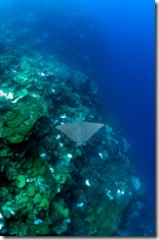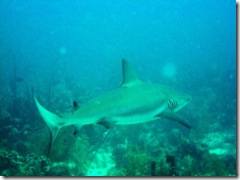Shooting fish.
A while ago I wrote about getting a new camera to take diving. Rather spookily one of the mails in my inbox when I got back from my dive trip last night was asking about underwater cameras , so here's what I replied about the new Canon
One of the observations of my recent dive trip was “You don’t buy the right dive kit first time ... it’s always the second one that’s right” I started with a 2002 vintage Pentax optio 430RS – which was 18 months old and made redundant by my purchase of a DSLR. I bought a housing and put it to use underwater. Not a great experience.
Learnings.
- Start-up time and Shutter lag matter a lot. Power saving means the camera will turn off during a dive. If it takes 6 seconds to power up and 2 seconds from press to take the shark that just swam by isn’t going to be captured.
- Batteries matter a bit. A camera with a dead battery on a dive boat .... You need spares. AA’s are a plus (you can raid a torch if need be !)
- Big, standard memory cards are good (on my trip someone had a fuji with XD cards, both laptops we had with us could read SD, one could read CF. But XD and memory stick – forget it.).
- Screen. The tiny screens of 2002 are usable underwater, but bigger is definitely better. A conventional view finder would be a hindrance underwater IMHO.
- Exposure. There’s less red light at depth. The Pentax would tend to over expose to try to compensate. An “Underwater mode” suggests the camera “gets it”
- Wide Angle and Macro. The more water between you and what you’re shooting, the more red light is absorbed and the more particles get in the way. Because of the usual underwater effects (Snell’s law) a 38mm equivalent lens becomes more like a 55mm underwater.
I went to cameras underwater’s web site and the only compacts I could find which ticked all the boxes were Canons (Pentax no longer do housings, Sony, Fuji, Olympus use daft memory, Casio batteries are proprietary, some Nikons use AAs but, it seems, not the ones with housings); with the 570IS looking the best with 7MP, 4x zoom, image stabilization and an underwater mode. (I got mine from AJ Electronics – who are currently quoting £114, for UK sourced product – when I bought ,it was £140 shipped, with £50 back from Canon)
The housing I imported from a company called Aiko trading for $199 US. I don’t shoot many Macros and the Canon focuses closer than Pentax did anyhow. I’d seen the Inon fish eye converter and wanted that to solve the wide angle issue – it promises huge depth of field and very close focusing too. I went with Aiko because they could supply the lens ($359) and the mounting kit for it ($75) as well as Canon’s housing. With shipping and import duty the extra bits cost about £370 (dwarfing the £90 the camera cost).
A purpose designed alternative would be Sealife’s DC600, but it’s less convenient out of the water, doesn’t support SDHC (high capacity) and costs more than the Canon + housing. It has a cheaper (though not as wide) wide angle converter but no Inon mounting kit. The Dive operator I was with last week rents out the Sealife, which suggests it’s reliable and easy to get on with (its buttons are easier to work with “fat fingers”)
I was worried that I had joined the “all the gear and no idea” brigade with all these bits, but the proof is in the pictures. They do need some tweaking afterwards (for contrast, and white balance - I’m going to try a magic filter at some stage). None of these pictures (or the one I posted earlier) would have been possible with my old set-up. So I’m happy. Not that I'd recommend other people buy the same - your mileage (or depth) WILL vary, but for anyone trying choose a camera that should give and idea of criteria to consider.
Technorati tags: Photography, Underwater, Scuba, Canon, Inon
Comments
- Anonymous
January 01, 2003
PingBack from http://macro-photography.fastlanenews.info/2007/11/13/shooting-fish/


